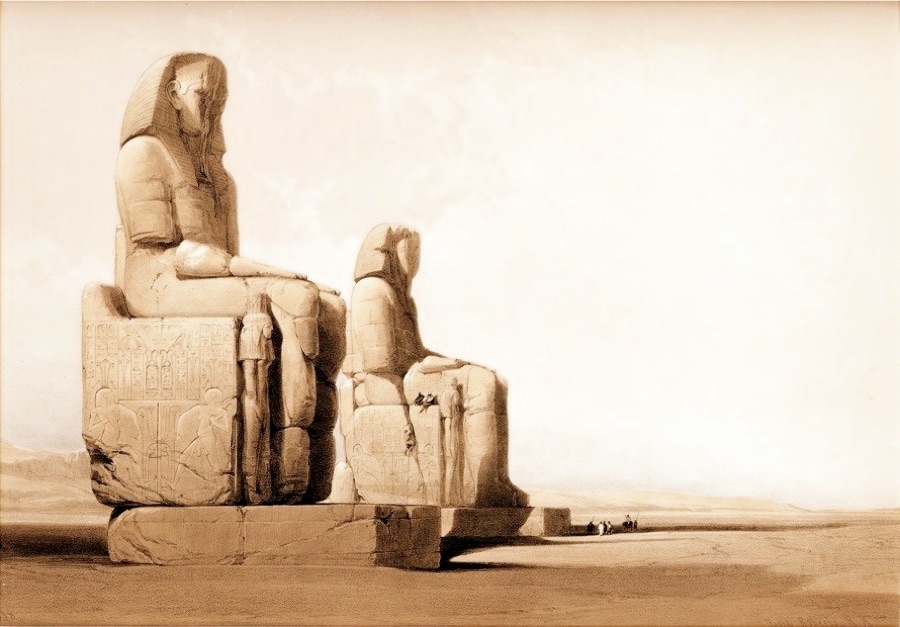THEBES; THE COLOSSAL STATUES OF AMUNOPH III.
THE view of these wonders of the plains of Thebes is taken from the upper or southern side of the group. The statues and their thrones, but not their pedestals, were originally hewn each out of a single stone; but the farthest of these, the well-known vocal Memnon, which will hereafter be described, having suffered disruption, had been restored. The material of these colossi is a coarse hard gritstone, slightly stained in some places with iron. The height of each is forty-seven feet, without the pedestal, but the total height before the accumulation of soil, which has buried so much of the pedestal, must have been sixty feet above the plain.
These enormous figures rest where they did at the period of their erection, when they formed the entrance of a grand dromos to the Temple, 1100 feet in length. Several pairs of statues, scarcely less colossal, originally formed the avenue, but of the others little more than fragments of the figures and of their pedestals can be traced: this avenue led to the Temple of Amunoph III. Many of the fragments are now buried in the alluvial deposit which each successive inundation of the Nile leaves, for at the period of high Nile the entire plain is so flooded that the waters reach the feet of these colossi, and have done so annually these 3300 years; leaving a tribute which has accumulated till the soil has risen seven feet above the level of the time of erection. Mr. Hay caused an excavation to be made below these statues, and ascertained that they rested on a bed of sand, retained by a wall of stone. The cartouche of Amunoph III. has been found upon these statues; but of the Temple to which the avenue, commencing with these colossi, led, a few substructions alone remain to mark the site of what must have held a conspicuous rank among the Temples of Thebes.
All the prominent features of these vast statues are now obliterated; the faces have flaked and fallen off. The massive head-dresses, which descend over the breast have, in their angles, preserved the ears. Sculptured for endurance, the severe and simple form of the Egyptian statue required the limbs to be in close contact with the body, or otherwise supported. Position without action is its characteristic: the legs are united to the throne, the arms to the body, and the fore-arms and hands to the thighs on which they rest. The smallest surface possible for its bulk is thus presented to the action of Time, who finds few weak points in Egyptian Art by which to insinuate his attacks: whence the marvellous preservation to our day of so many of its magnificent remains. This statue may have been seen by Moses, for it was erected, three-and-thirty centuries ago, by that Pharaoh in whose reign the Israelites were led forth by the great lawgiver from their bondage in Egypt.
The sides of the thrones are similarly ornamented with hieroglyphics, by which the dominion of the sovereigns over Upper and Lower Egypt is supposed to be typified by figures of the god Nilus binding the stalks of two different water-plants round the support of a tabular frame, or stelæ, that contains the ovals and characters which probably record the erection of these colossi. A line of hieroglyphics also extends from the shoulder down the back to the pedestal, and here is found the name of the Pharaoh whom the statue represented, Amunoph III. On either side stand, attached to the throne, statues of the wife and the mother of the Pharaoh, eighteen feet high; and there are traces of a smaller statue of his queen between his feet.
The figures seen climbing up the throne of the vocal Memnon are Messrs. Hurnard and Corry, who were at time Mr. Roberts’s travelling companions.
Wilkinson’s Egypt and Thebes. Wathen’s Arts and Antiques of Egypt.


